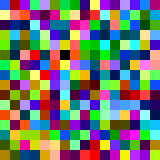A simple python-based command-line utility to to visualize random blobs of data. It is heavily inspired by pixd made by FireFly: https://github.com/FireyFly/pixd
vizme can be used convert a raw data-stream to a visual representation in image format (or terminal viewing in ANSI).
vizme is installed as a command-line utility accessible as vizme from the command-line. Vizme has a (small) help menu.
For the most part vizme expects input data from either a filepath or from /dev/stdin and a way to output it. By default
vizme will output the data in PNG format which can be written to a file.
The help section:
vizme -h
usage: vizme [-h] [-t] [-w WIDTH] [-s SCALE] [-p {pixd,greyscale}]
[INPUT] [OUTPUT]
positional arguments:
INPUT Data to convert (can be a file, don't specify for
stdin)
OUTPUT Where to write output to (can be a file, don't specify
for stdout)
optional arguments:
-h, --help show this help message and exit
-t, --terminal Sets output to be terminal (colored) ANSI.
-w WIDTH, --width WIDTH
Output columns width
-s SCALE, --scale SCALE
Scales the output pixels (2 means 2 times the amount
of columns/rows for the same data)
-p {pixd,greyscale}, --palette {pixd,greyscale}
Sets the palette to use for output
We can take some data from /dev/random and pipe it through head to limit it to 256 bytes, set a width of 16 and pipe it to a PNG file:
cat /dev/random | head -c256 | vizme -w16 > image.png
Which gives us a really tiny PNG with random data using the default palette.
We can scale it up times 10 to see whats going on:
cat /dev/random | head -c256 | vizme -w16 -s10 > image.png
Which gives us a bigger image:
vizme also has a terminal output option which outputs ANSI full-block characters with the same color output.
This is the very bare-basic of what you can do with vizme. While it doesn't have implementations for image manipulation
or some specific data cutting from what it reads/writes you can do this yourself on the command-line quite easily.
If you still want to see a feature in vizme feel free to raise tickets / pull requests.
Converting the PNG output to JPG (or any image format) which requires imagemagick:
cat /dev/random | head -c256 | vizme -w16 -s10 | convert /dev/stdin my_image.jpg
Previewing your output image in your terminal, required imgcat shell extension:
cat /dev/random | head -c256 | vizme -w16 -s10 | imgcat
vizme comes with two palettes by default. Standard output uses the pixd palette and also contains a greyscale:
cat /dev/random | head -c256 | vizme -w16 -s10 -p greyscale | imgcat
Feel free to report issues, this 'utility' was build out of ease as I needed something to visualize a data format I was trying to figure out.



